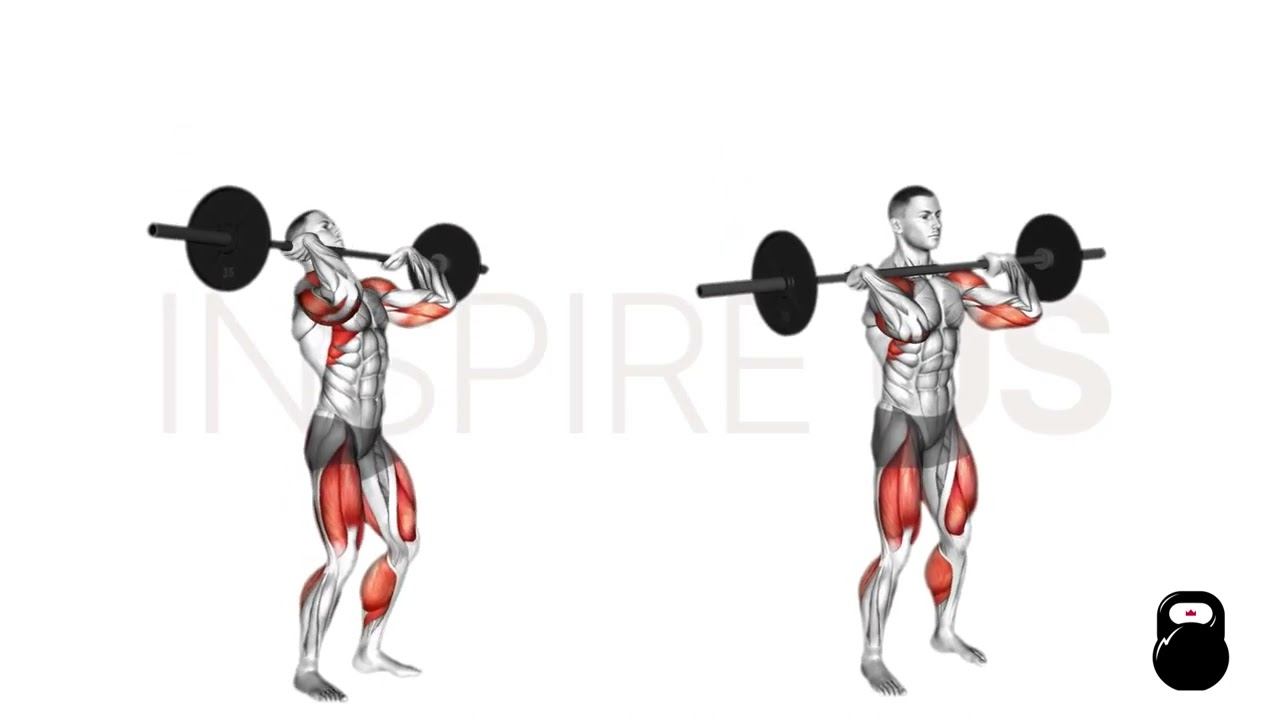Push Jerk vs Push Press: The Differences Explained
The push jerk and push press are two distinct barbell exercises employed by weightlifters to build power in the upper body.
Despite their similarity in name, both movements are meant to be used in separate contexts according to their unique characteristics.
Although more complex than it sounds, the push jerk and push press are primarily differentiated according to the technique involved. The push press uses a dip in the legs to generate momentum, whereas the push jerk requires the lifter to drop beneath the bar as well.
What is the Push Jerk?
The push jerk is a compound triple extension exercise where the lifter will perform a push press prior to dipping beneath the weight. When programmed, it is performed with significant weight and a moderate amount of volume with each set.
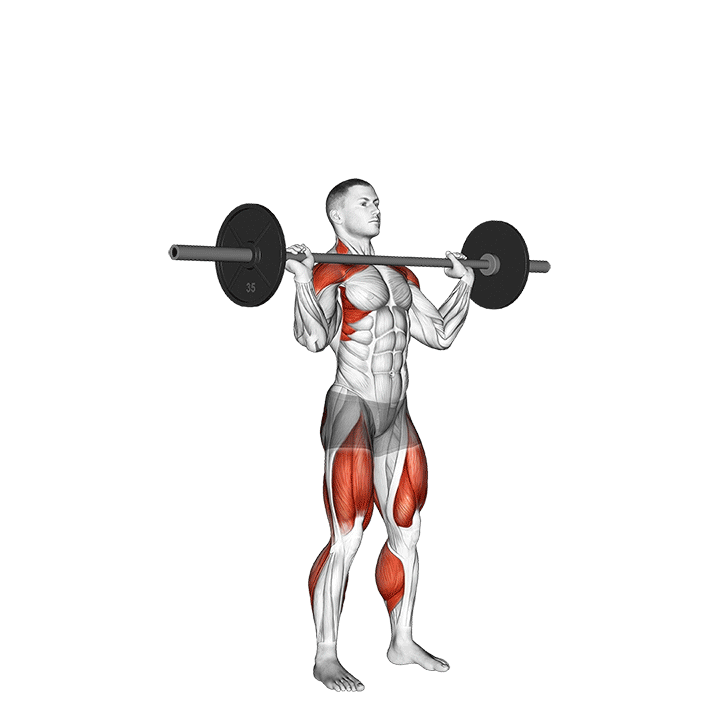
The push jerk is a particular favorite among athletes and individuals wishing to build full-body explosiveness, as it targets not only the muscles of the shoulders but also much of the lower body as well.
Advantages of the Push Jerk
The main advantage to doing push jerks is its capacity for building athleticism throughout the entire body. Speed, strength and control are just a few of the abilities developed by the push jerk.
In addition, the push jerk is particularly useful as a training tool for Olympic weightlifters and other types of weightlifting athletes.
How-to Push Jerk
To perform a push jerk, the lifter will begin by racking the barbell atop their collarbones, hands set wider than shoulder-width apart. This starting position is identical to that of a strict press and push press.
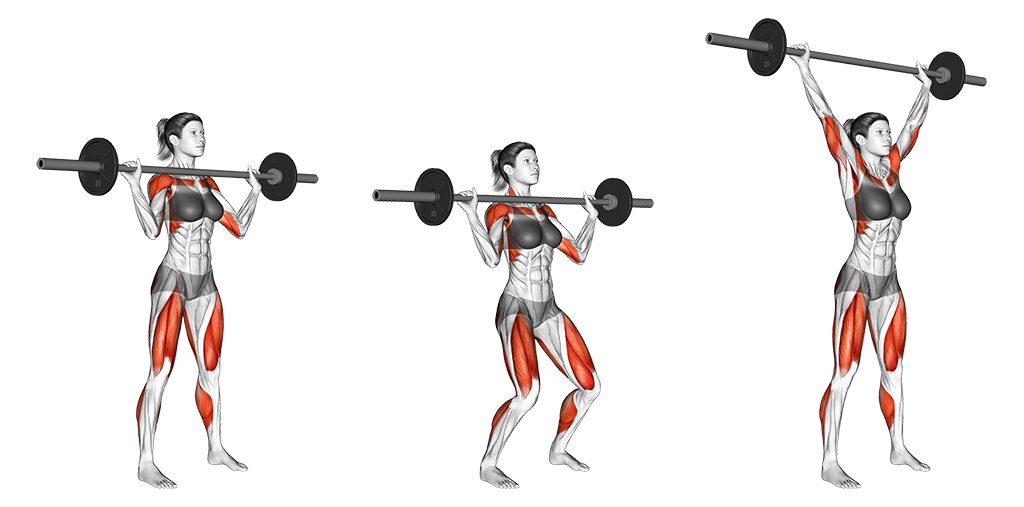
Now in the correct stance, the lifter will continue by dipping at the knees and pushing the barbell upwards.
As the barbell rises upwards, they will bend the legs once more - dropping beneath the bar as they continue to press it overhead. With the arms fully extended, they will rise out of the squat.
Once standing upright with the bar held overhead, the repetition is considered to be complete.
What is the Push Press?
The push press is a compound barbell exercise used to build greater explosiveness and strength than what would be possible with a strict press. Its name comes from the additional “push” provided by the lower body during the exercise, where the knees bend so as to generate momentum.
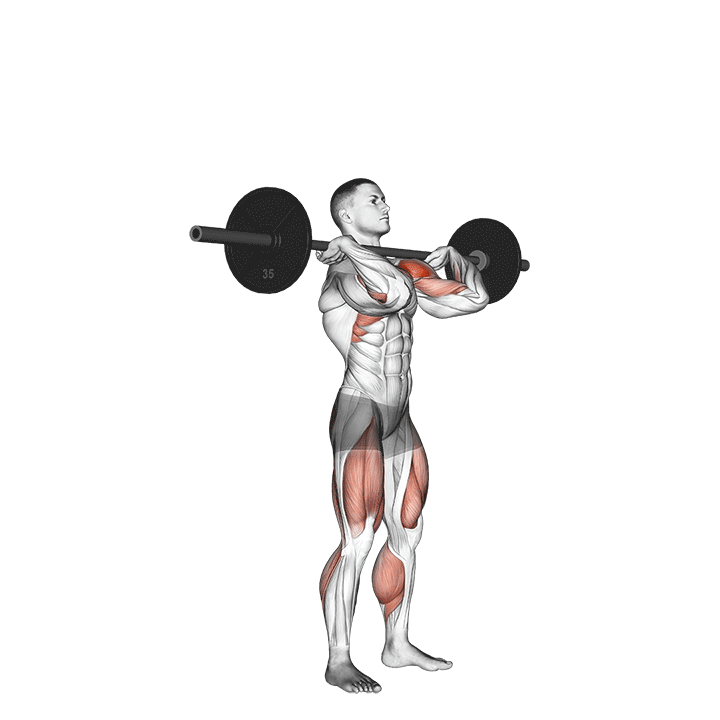
Because of its explosive nature, the push press will generally feature greater amounts of weight than most other shoulder exercises - and is performed for low or moderate volume sets.
Advantages of the Push Press
The main advantage of the push press is its involvement of the entire body - of which is used to push the barbell overhead in an explosive manner. This builds power in not only the shoulders but also the legs, and carries over quite well to many athletic or real world activities.
How-to Push Press:
To perform a repetition of the push press, the lifter will begin by placing the barbell in the front rack position, both hands set wider than shoulder-width apart.
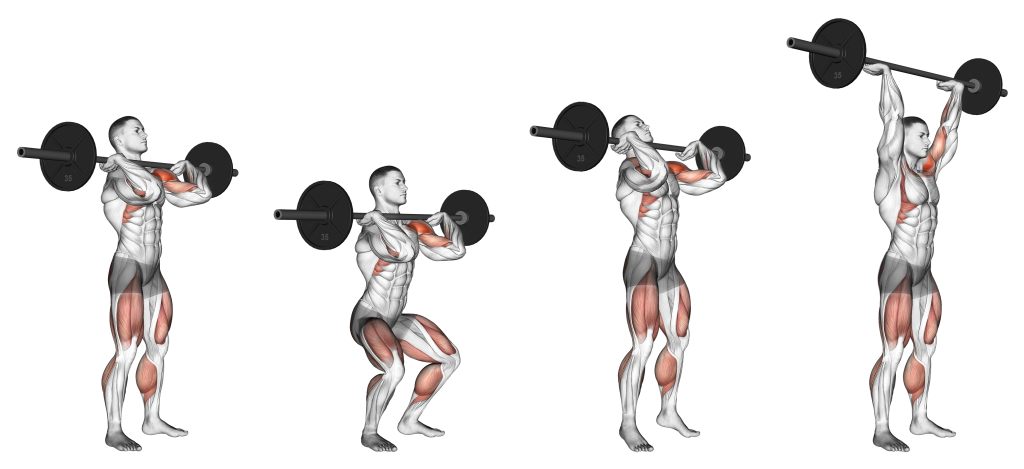
Once in the appropriate stance, the repetition begins with the lifter bending at the hips and knees slightly, contracting their core and protecting the spine as they do so.
Generating momentum by rapidly extending the hips and knees, the lifter will push the barbell overhead in a simultaneous manner.
Once the arms are fully extended overhead, the repetition is considered to be complete.
Push Jerk vs Push Press - Muscles Worked
The push jerk and push press both primarily target the deltoids, but differ in terms of recruitment intensity concerning other muscle groups.
In particular, the usage of lower body musculature and the extent to which the core is contracted are both more intense with the push jerk.
This means that the push press is both less intense and more shoulder-focused in nature.
Emphasis on Lower Body Musculature
Although both exercises involve the lower body’s muscles to a certain extent, the push jerk involves a far deeper dip and more closely replicates a squat than a strict press. This means that the push jerk works the quadriceps, hamstrings and glutes far more than the push press.
Stabilizer Muscle Recruitment
Apart from the mobilizer muscles, both the push jerk and push press contract the core and erector spinae isometrically.
However, the intensity of this contraction is once again more intense with the push jerk, as it features a deeper squat and as such requires said stabilizers to work harder to keep the torso upright.
Push Jerk vs Push Press - Movement Pattern and Technique
As mentioned at the start of this article, the push jerk and push press primarily differ in terms of technique.
The push jerk features a deeper squat and requires the lifter to “catch” the barbell above them, whereas the push press is simply a leg-assisted overhead press. These differences in movement and technique alter the intensity of either exercise, and cause them to produce different results.
Range of Motion
While both push jerk and press involve a full arm range of motion (to full extension), the lower body’s range differs between the two.
As covered in the previous section, this means that the push jerk targets the legs to a greater degree as it involves a deeper squatting motion.
In addition, the distance in which the barbell moves during the push jerk is somewhat shorter in comparison to the press, creating an overall more efficient movement.
However, this also means that less momentum is generated by the lower body during a push press - leading to lesser instability and greater deltoid recruitment in comparison.
Press vs Catch
The term “press” in weightlifting refers to a movement pattern involving pushing an object away from the body.
Although both the push jerk and push press make use of a pressing motion, the push jerk involves a second movement where the lifter dips beneath the bar and catches it while partially squatting. This catch aids in securing the barbell, as well as produces significantly more power - hence the greater loading capacity of the push jerk.
Of course, the difference in mechanics also means that the push press is significantly easier to learn, and should in fact be mastered prior to trying a full push jerk.
Generation of Momentum
In terms of gross force production, the push press and push jerk differ by which set of muscles is most at play.
The push jerk will derive more force from the lower body, whereas the push press will need to rely more on the deltoids and triceps, as less power is outputted by the legs.
This naturally means that the latter exercise will also be lighter and involve lesser loading capacity, as the triceps and deltoids are nowhere near as strong as the leg muscles.
Push Jerk vs Push Press - Maximal Loading and Difficulty
With the differences in technique, muscular recruitment and range of motion, it should be no surprise that the push jerk and push press differ in terms of complexity and loading.
The push jerk allows for more weight to be moved with each repetition, but is also more technically complex in comparison to the lighter and simpler push press.
Loading Capacity
When referring to an exercise, the term “loading capacity” simply signifies how much weight can reasonably be moved at a certain level of exertion. Some exercises place the body in a disadvantageous position or are otherwise technically complex, meaning that less weight will be moved.
There are advantages and disadvantages to an exercise having a significant potential for weight load. But, for the purposes of comparing the push jerk and push press, it largely comes down to acclimating the lifter to heavy weight.
In this particular case, the push jerk is considered better. Despite being more complex in execution, greater momentum is generated by the lower body in comparison to the push press - and the bar moves through a shorter range of motion as well.
Both these aspects increase how much weight may be loaded onto the barbell. For maximal weight lifted, the push jerk is the better choice.
Complexity of Execution
In terms of how technical and complex either exercise is, the push press is considered to be both simpler and more accessible.
Not only does it involve a lesser need for mastery of triple extension mechanics, but the push press is also quite simple in comparison to the push jerk.
For novices or individuals who possess difficulty in coordinating their movements, the push press is the better exercise to pick. Once you’ve mastered it, it is entirely possible to pick up the push jerk as a progression exercise.
Push Jerk vs Push Press - Applicability to Olympic Weightlifting
One common reason why the push jerk and push press are compared is for Olympic weightlifting training.
In competitive Olympic weightlifting events, one of the two main event exercises is the clean and jerk. As you may guess, this is much the same “jerk” as the one that takes place in a push jerk.
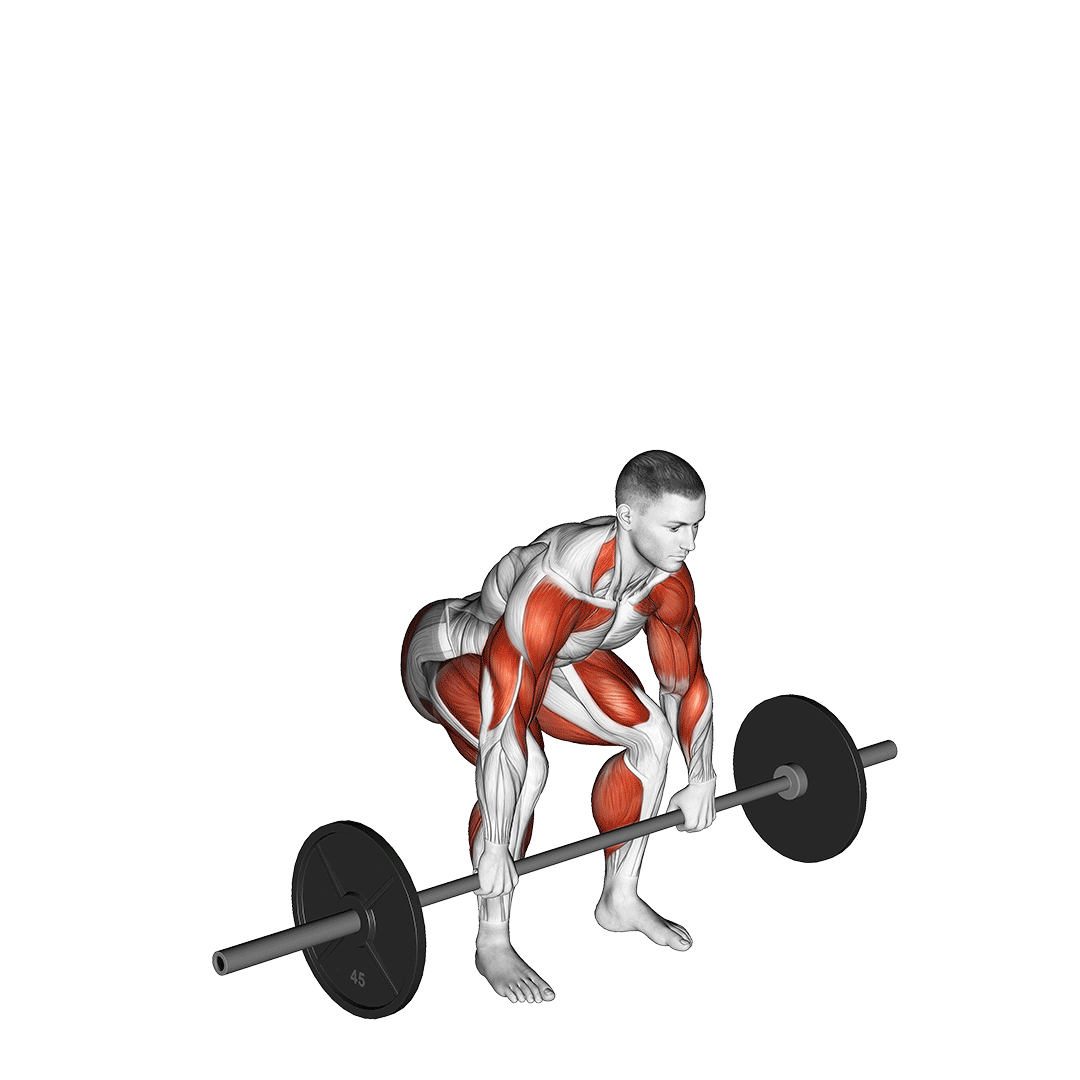
As such, the majority of Olympic weightlifters may be better off picking the push jerk over the push press purely because of its carryover to actual competitive lifting. While the push press can indeed help build the necessary strength and familiarity to improve your Olympic lifts, the push jerk is closer in actual execution.
Frequently Asked Questions (FAQ)
Is the Push Press or Push Jerk Easier?
The push press is easier to learn and somewhat more simple in execution. However, the push jerk allows the legs to “help” the shoulders out more, as it features a deeper squatting movement.
In the end, it is up to what you consider to be an easy exercise - gross intensity or technical form.
What is the Difference Between a Push Jerk and the Shoulder Press?
The push jerk involves the lifter entering a half squat and driving through their legs so as to jerk a barbell overhead. In comparison, the shoulder press is strict, uses no lower body momentum, and solely works the upper body muscles.
What is the Best Press Exercise for Shoulders?
The best press exercise for the shoulders comes down to individual needs. However, you can’t go wrong with the basic overhead press, as it is the most reliable deltoid-focused press out there.
Which Exercise is Better, the Push Jerk or Push Press?
If you’ve tallied up all the differences between these two seemingly similar exercises, you’ve likely come to the conclusion that neither exercise is necessarily better than the other.
The push jerk is useful for Olympic weightlifters, individuals who wish to move as much weight as possible or those who wish to focus more on lower body force generation.
In comparison, the push press is better for those who wish to emphasize the deltoids more, or individuals who find the push jerk to be too technical in form.
Regardless of which push you’ve chosen to perform, remember to follow proper form to the letter - and to follow appropriate preparatory work, especially for explosive exercises such as these.
References
1. Soriano MA, Suchomel TJ, Comfort P. Weightlifting Overhead Pressing Derivatives: A Review of the Literature. Sports Med. 2019 Jun;49(6):867-885. doi: 10.1007/s40279-019-01096-8. PMID: 30924081; PMCID: PMC6548056.
2. Bishop, Chris & Chavda, Shyam & Turner, Anthony. (2017). Exercise Technique: The Push Press. Strength and Conditioning Journal. 40. 1. 10.1519/SSC.0000000000000321.
3. Soriano, Marcos & García Ramos, Amador & Torres-González, Antonio & Castillo-Palencia, Joaquín & Marín, Pedro & Sainz de Baranda, Pilar & Comfort, Paul. (2019). Comparison of 1-Repetition-Maximum Performance Across 3 Weightlifting Overhead Pressing Exercises and Sport Groups. International Journal of Sports Physiology and Performance. 15. 1-6. 10.1123/ijspp.2019-0582.

